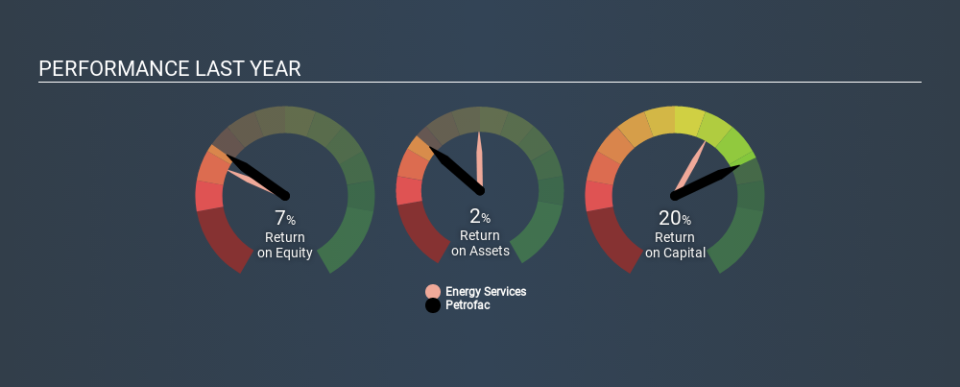Is Petrofac Limited’s (LON:PFC) 20% ROCE Any Good?

Today we'll evaluate Petrofac Limited (LON:PFC) to determine whether it could have potential as an investment idea. To be precise, we'll consider its Return On Capital Employed (ROCE), as that will inform our view of the quality of the business.
First, we'll go over how we calculate ROCE. Then we'll compare its ROCE to similar companies. Then we'll determine how its current liabilities are affecting its ROCE.
Return On Capital Employed (ROCE): What is it?
ROCE measures the amount of pre-tax profits a company can generate from the capital employed in its business. Generally speaking a higher ROCE is better. Ultimately, it is a useful but imperfect metric. Renowned investment researcher Michael Mauboussin has suggested that a high ROCE can indicate that 'one dollar invested in the company generates value of more than one dollar'.
How Do You Calculate Return On Capital Employed?
The formula for calculating the return on capital employed is:
Return on Capital Employed = Earnings Before Interest and Tax (EBIT) ÷ (Total Assets - Current Liabilities)
Or for Petrofac:
0.20 = US$406m ÷ (US$6.0b - US$3.9b) (Based on the trailing twelve months to December 2019.)
Therefore, Petrofac has an ROCE of 20%.
View our latest analysis for Petrofac
Is Petrofac's ROCE Good?
ROCE can be useful when making comparisons, such as between similar companies. Petrofac's ROCE appears to be substantially greater than the 13% average in the Energy Services industry. I think that's good to see, since it implies the company is better than other companies at making the most of its capital. Setting aside the comparison to its industry for a moment, Petrofac's ROCE in absolute terms currently looks quite high.
In our analysis, Petrofac's ROCE appears to be 20%, compared to 3 years ago, when its ROCE was 16%. This makes us wonder if the company is improving. You can see in the image below how Petrofac's ROCE compares to its industry. Click to see more on past growth.
When considering this metric, keep in mind that it is backwards looking, and not necessarily predictive. ROCE can be misleading for companies in cyclical industries, with returns looking impressive during the boom times, but very weak during the busts. This is because ROCE only looks at one year, instead of considering returns across a whole cycle. Given the industry it operates in, Petrofac could be considered cyclical. What happens in the future is pretty important for investors, so we have prepared a free report on analyst forecasts for Petrofac.
How Petrofac's Current Liabilities Impact Its ROCE
Current liabilities are short term bills and invoices that need to be paid in 12 months or less. The ROCE equation subtracts current liabilities from capital employed, so a company with a lot of current liabilities appears to have less capital employed, and a higher ROCE than otherwise. To counteract this, we check if a company has high current liabilities, relative to its total assets.
Petrofac has current liabilities of US$3.9b and total assets of US$6.0b. As a result, its current liabilities are equal to approximately 66% of its total assets. Petrofac's high level of current liabilities boost the ROCE - but its ROCE is still impressive.
Our Take On Petrofac's ROCE
In my book, this business could be worthy of further research. There might be better investments than Petrofac out there, but you will have to work hard to find them . These promising businesses with rapidly growing earnings might be right up your alley.
If you like to buy stocks alongside management, then you might just love this free list of companies. (Hint: insiders have been buying them).
Love or hate this article? Concerned about the content? Get in touch with us directly. Alternatively, email editorial-team@simplywallst.com.
This article by Simply Wall St is general in nature. It does not constitute a recommendation to buy or sell any stock, and does not take account of your objectives, or your financial situation. We aim to bring you long-term focused analysis driven by fundamental data. Note that our analysis may not factor in the latest price-sensitive company announcements or qualitative material. Simply Wall St has no position in any stocks mentioned. Thank you for reading.

